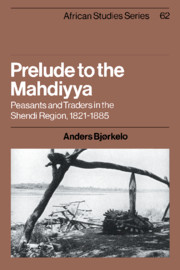Book contents
- Frontmatter
- Contents
- Figures
- List of maps
- List of tables
- Preface
- Acknowledgements
- Abbreviations
- Weights and measures
- The Sudan in the nineteenth century
- Introduction
- 1 The Ja'alī Kingdom of Shendi and its destruction
- 2 Shendi's economy on the eve of the Turkiyya
- 3 The Ja'aliyyīn under Turkish administration
- 4 The transformation of agriculture
- 5 Taxation
- 6 The transformation of commerce
- 7 Conclusion: dispersion and return
- Appendix: Three contracts from the archive of 'Abd Allāh Bey Ḥamza
- Notes
- Sources and bibliography
- Index
- OTHER BOOKS IN THE SERIES
1 - The Ja'alī Kingdom of Shendi and its destruction
Published online by Cambridge University Press: 31 October 2009
- Frontmatter
- Contents
- Figures
- List of maps
- List of tables
- Preface
- Acknowledgements
- Abbreviations
- Weights and measures
- The Sudan in the nineteenth century
- Introduction
- 1 The Ja'alī Kingdom of Shendi and its destruction
- 2 Shendi's economy on the eve of the Turkiyya
- 3 The Ja'aliyyīn under Turkish administration
- 4 The transformation of agriculture
- 5 Taxation
- 6 The transformation of commerce
- 7 Conclusion: dispersion and return
- Appendix: Three contracts from the archive of 'Abd Allāh Bey Ḥamza
- Notes
- Sources and bibliography
- Index
- OTHER BOOKS IN THE SERIES
Summary
The Ja'aliyyīn Group claim to descend from al-'Abbās, the uncle of the Prophet, through one Ibrahim Ja'al or Ju'al. Leaving aside the Ja'alī tribes of the White Nile and Kordofan, whose names are derived from the root j.m., ‘to gather’, or ‘collect’, and the Danāgla of Dongola, who should perhaps not be rated among the Ja'aliyyīn at all, we are left with five major riverain Ja'alī tribes. The Shāyqiyya (roughly between Kurtī and Hōsh al-Jurūf), the Manā⋅īr (Ḥōsh al-Jurūf to Hawīla Island), the Rubafab (Hawīla to 'Ushayr Island), the Mīrafāb (from 'Ushayr to the Atbara River), and the Ja'aliyyīn proper (from Atbara to the Sixth Cataract). Although informants may today admit that their Arab ancestors married Nubian women, the genealogical tree of the Ja'aliyyln is a ‘deliberate attempt to ignore the Nubian sub-stratum that the Arab immigrants had submerged’.
Interpretations of the meaning of Ibrāhīm's nickname Ja'al or Ju'al may throw some light on this question. The most common interpretation is that it stems from;j.'l., ‘to make’. Ibrāhīm is said to have ‘made’ or incorporated people hit by famine into his own people by giving them food, shelter and protection. Another and less well-known tradition links his nickname to the colour of his skin. It is said that he was very black and that his grandmother used to call him 'Ju‘al’, a black beetle. There are, furthermore, many traditions relating to the early relationship between the Arabs and the Nubians, but a study of how the Nubians became Arabs lies beyond the scope of this study.
- Type
- Chapter
- Information
- Prelude to the MahdiyyaPeasants and Traders in the Shendi Region, 1821–1885, pp. 7 - 14Publisher: Cambridge University PressPrint publication year: 1989

